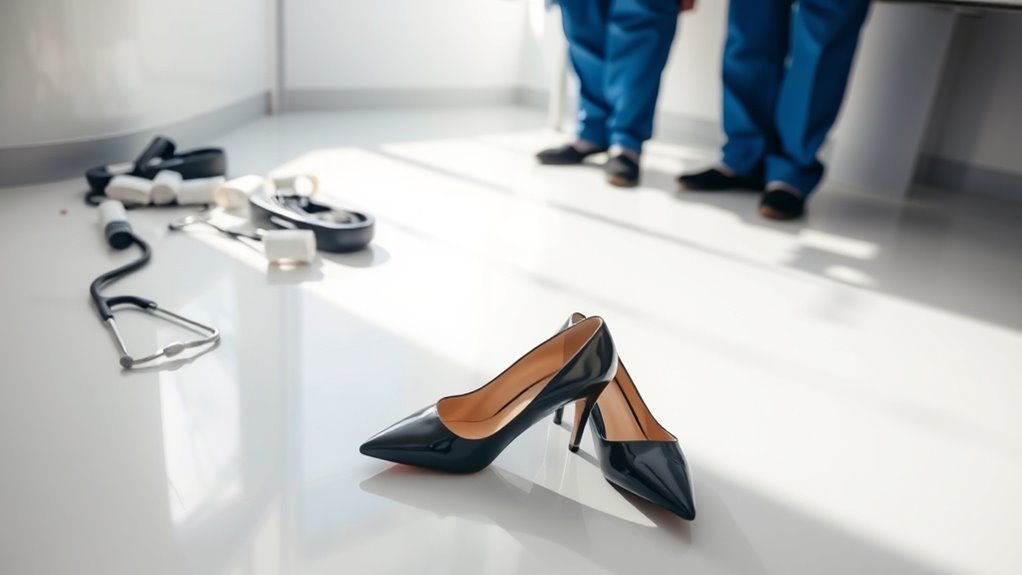Doctors and nurses should prioritize comfort and safety over style when selecting footwear. While heels may look professional, they can lead to foot ailments, especially during long shifts. It is crucial to choose shoes with a supportive structure, slip-resistant soles, and breathable materials. Many healthcare professionals opt for stylish flats or low heels that offer better support without compromising appearance. To find the best options for your work environment, consider specific footwear features that enhance comfort and functionality.
The Importance of Footwear in Healthcare

Footwear plays an essential role in the healthcare profession, impacting both comfort and performance. For doctors and nurses, the right shoes are critical for maintaining foot health during long shifts. Poor footwear can lead to issues such as plantar fasciitis, bunions, and other ailments that hinder your ability to provide care.
When selecting shoes, consider the footwear materials. Breathable, moisture-wicking fabrics can help keep your feet dry and reduce the risk of fungal infections, while durable soles provide necessary support and traction on slippery surfaces. Additionally, cushioning is indispensable; it absorbs shock and minimizes fatigue, allowing you to stay focused on your patients rather than your aching feet.
Comfort vs. Style: The Dilemma
Finding the right balance between comfort and style can be a significant challenge for healthcare professionals. You want to look professional while ensuring your feet are supported during long shifts. With evolving workplace trends, fashion choices are becoming more versatile, but comfort shouldn’t be sacrificed.
Here’s a quick comparison to help guide your decisions:
| Comfort | Style |
|---|---|
| Cushioned insoles | Trendy designs |
| Breathable materials | Eye-catching colors |
| Supportive structures | Fashion-forward shapes |
| Slip-resistant soles | Elegant finishes |
When choosing footwear, consider how each option aligns with your needs. It’s essential to find shoes that not only look good but also provide the support necessary for your demanding role. Ultimately, your footwear should reflect both your professional image and your comfort, allowing you to perform at your best.
Understanding Workplace Dress Codes

Understanding workplace dress codes is essential for maintaining a professional appearance while ensuring safety and comfort. You’ll find that standards can vary greatly between institutions, reflecting their unique policies and cultures. Familiarizing yourself with these guidelines helps you navigate what’s acceptable in your role as a healthcare professional.
Professional Appearance Standards
How does one navigate the often complex landscape of professional appearance standards in healthcare settings? Understanding these standards is essential for maintaining a professional image. Professional attire not only reflects your competence but also shapes the image perception of patients and colleagues. Each institution may have its own dress code, which often emphasizes cleanliness, modesty, and functionality. While scrubs are common, some roles may allow for more personalized attire, as long as it aligns with professional expectations. Remember, your appearance can influence trust and confidence in your abilities. Adhering to these standards helps foster a positive environment and guarantees that you’re seen as a reliable healthcare provider. Always check with your institution’s guidelines to confirm compliance.
Safety and Comfort Considerations
While maintaining a professional appearance is important, safety and comfort in your attire should also be a top priority in healthcare settings. Wearing heels may affect your stability and increase the risk of slips or falls, especially during long shifts. Instead, consider footwear with ergonomic designs that provide proper support and cushioning. These heel alternatives can help reduce fatigue and improve your overall mobility throughout the day. Look for shoes that offer non-slip soles and ample toe space to guarantee a secure fit, allowing you to focus on patient care rather than discomfort. Prioritizing safety and comfort not only protects you but also enhances your ability to perform your duties effectively in a demanding environment.
Institutional Policy Variations
Although workplace dress codes can vary greatly from one healthcare institution to another, it’s crucial to familiarize yourself with your specific organization’s policies regarding footwear. Many institutions have established dress code guidelines that explicitly address acceptable shoe types, including the height and style of heels. Some may allow low-heeled shoes for doctors or nurses, while others might restrict any heel altogether to prioritize safety and comfort. Always check your institutional policies to guarantee compliance, as failing to adhere can lead to disciplinary action. Understanding your workplace’s dress code not only reflects professionalism but also contributes to a safe environment for both staff and patients. So, before slipping on those heels, make certain you’re informed about your organization’s requirements.
The Impact of Long Shifts on Foot Health

When you’re on your feet for long shifts, the toll it takes on your foot health can be significant. Prolonged standing increases foot fatigue and can lead to various issues if proper care isn’t taken. Here are four critical factors to take into account for maintaining foot health during those demanding hours:
- Arch Support: Shoes with adequate arch support are essential to distribute weight evenly and reduce pressure on your feet.
- Cushioning: Opt for footwear with good cushioning to absorb impact, minimizing stress on your feet and joints.
- Fit: Confirm your shoes fit well; tight or loose shoes can exacerbate discomfort and lead to blisters.
- Breaks: Whenever possible, take short breaks to sit down and relieve pressure, helping to combat foot fatigue.
Safety Considerations for Footwear Choices
When choosing footwear in a clinical setting, slip resistance is essential to prevent accidents on potentially wet or slick surfaces. Additionally, proper foot support is necessary to maintain comfort during long shifts and reduce fatigue. Prioritizing these safety considerations can greatly impact your performance and wellbeing.
Slip Resistance Importance
As healthcare professionals navigate busy hospital environments, the importance of slip-resistant footwear cannot be overstated. Choosing the right shoes can greatly reduce the risk of falls and injuries. Here are four key factors to take into account regarding slip resistance:
- Slip Resistant Materials: Look for shoes made from rubber or specialized composites that enhance grip.
- Footwear Traction: Select soles designed with patterns that maximize contact with surfaces to prevent slips.
- Water and Chemical Resistance: Confirm your shoes can withstand spills and cleaning agents commonly found in hospitals.
- Proper Fit: Ill-fitting shoes can increase the risk of slipping, so always choose the right size and style for your needs.
Investing in slip-resistant footwear is essential for maintaining safety and efficiency in healthcare settings.
Foot Support Necessity
While you might be tempted to wear stylish shoes, the necessity of proper foot support in healthcare settings cannot be ignored. Your feet endure long hours of standing and moving, so prioritizing comfort is essential. Shoes with adequate arch support can greatly enhance your foot health, reducing fatigue and preventing injuries. High heels often lack the necessary support, leading to discomfort and potential long-term damage. Remember, a good shoe should promote proper alignment and cushioning. Look for options designed specifically for healthcare professionals, as they often combine style with vital support features. Ultimately, investing in well-structured footwear not only keeps you comfortable but also allows you to perform your duties more effectively and safely.
The Role of Slip-Resistant Shoes
Slip-resistant shoes play an essential role in the healthcare environment, where the risk of slips and falls is significant. Wearing the right footwear can greatly enhance your safety and performance. Here are four key aspects to evaluate when choosing slip-resistant shoes:
Slip-resistant shoes are vital in healthcare settings, significantly reducing the risk of slips and enhancing safety and performance.
- Slip Resistant Materials: Look for shoes made with specific slip-resistant materials designed to minimize slipping on wet or oily surfaces.
- Traction Technology: Choose footwear that incorporates advanced traction technology for better grip, especially in high-traffic areas.
- Comfort and Fit: Confirm your shoes offer a comfortable fit, as this can reduce fatigue during long shifts and improve overall stability.
- Durability: Opt for shoes that can withstand the rigorous demands of a healthcare setting without compromising safety features.
Alternatives to High Heels for Professional Attire
If you’re looking for alternatives to high heels in professional settings, there are several great options. Comfortable flat shoes and supportive sneakers can keep you on your feet without sacrificing style or comfort. Additionally, stylish low heels offer a polished look while providing better support for long shifts.
Comfortable Flat Shoes
Finding the right footwear is essential for healthcare professionals who spend long hours on their feet. Comfortable flat shoes can provide the support you need while maintaining a professional appearance. Here are four key features to look for:
- Comfortable shoe materials: Choose shoes made from breathable fabrics or cushioned insoles to enhance comfort.
- Lightweight shoe designs: Opt for shoes that won’t weigh you down, allowing for easy movement throughout your day.
- Arch support: Look for flat shoes with built-in arch support to help prevent foot fatigue.
- Non-slip soles: Safety is vital, so select shoes with non-slip soles to reduce the risk of accidents in clinical settings.
Prioritizing these features can greatly improve your comfort and performance at work.
Supportive Sneakers Options
While high heels may add a touch of elegance to professional attire, supportive sneakers offer a practical and comfortable alternative for healthcare professionals. These sneakers come in various fashionable designs that guarantee you can maintain a polished appearance while prioritizing comfort. Brands like Nike, Adidas, and Skechers have developed options specifically tailored for those on their feet all day, featuring cushioned insoles and breathable materials. You don’t have to sacrifice style for comfort; many supportive sneakers boast sleek silhouettes and trendy colors, making them suitable for any work environment. By choosing supportive sneakers, you’ll enhance your overall well-being and performance during long shifts, allowing you to focus on providing the best care to your patients.
Stylish Low Heels
Supportive sneakers are a fantastic choice for all-day comfort, but if you’re looking for a more polished look without sacrificing your feet’s well-being, stylish low heels can be a great alternative. These stylish alternatives typically have a lower heel height, making them easier to wear during long shifts. Consider these options:
- Block Heels: Provide stability and comfort while still looking chic.
- Kitten Heels: Offer a subtle lift and are perfect for professional settings.
- Wedges: Distribute weight evenly, reducing pressure on your feet.
- Loafers with a Heel: Combine elegance and practicality, ideal for a healthcare environment.
With these choices, you can maintain a professional appearance while prioritizing comfort.
Personal Testimonials From Healthcare Professionals
Many healthcare professionals have strong opinions about wearing heels on the job, and their experiences shed light on the practicalities involved. Nurses often share their high heel experiences, noting that while they can elevate an outfit, they may compromise comfort during long shifts. One nurse mentioned, “I used to wear heels to look professional, but I quickly switched to flats for my sanity.” On the other hand, some doctors express a preference for stylish low heels, finding them more suitable for a busy environment. They argue that footwear preferences should prioritize functionality over fashion. A doctor reflected, “Heels can be a confidence boost, but practicality wins when you’re on your feet all day.” Ultimately, these testimonials highlight the delicate balance between maintaining a polished appearance and ensuring comfort in a demanding career. The choice of footwear can greatly impact the daily experiences of healthcare professionals.
Tips for Choosing Appropriate Footwear
Choosing the right footwear for a demanding healthcare job is essential for both comfort and performance. With the right shoes, you can navigate long shifts and unpredictable environments with ease. Here are some tips to guide your choice:
- Prioritize Comfort: Look for shoes with cushioned insoles and arch support to prevent foot fatigue.
- Consider Shoe Materials: Opt for breathable, moisture-wicking materials that keep your feet dry and reduce odor.
- Stay Updated on Footwear Trends: Keep an eye on new styles that blend functionality with professionalism, ensuring you remain stylish yet practical.
- Check for Slip Resistance: Choose shoes with non-slip outsoles to enhance safety in potentially hazardous areas.
Balancing Professionalism and Comfort in the Workplace
While it’s important to project a professional image in healthcare settings, comfort shouldn’t take a back seat, especially during long shifts. Finding the right balance between workplace attire and personal comfort is essential for your performance and well-being. Many healthcare professionals face the challenge of adhering to formal dress codes while also keeping up with evolving fashion trends.
Opting for supportive footwear that aligns with these trends can enhance your confidence without sacrificing comfort. Look for shoes designed specifically for healthcare, which often combine style with ergonomic features. Additionally, consider fabrics and fits that allow for ease of movement while maintaining a polished appearance.
Frequently Asked Questions
Are There Specific Heel Heights Recommended for Healthcare Professionals?
Studies show that 60% of healthcare professionals experience foot pain. For comfort and safety, heel height recommendations suggest staying below two inches. Proper professional attire includes supportive footwear to maintain health during long shifts.
Can Wearing Heels Lead to Long-Term Foot Health Issues?
Wearing heels can indeed lead to long-term foot health issues. You might experience heel discomfort, which may contribute to conditions like plantar fasciitis or bunions. It’s essential to prioritize comfort and support for your feet.
Do Different Healthcare Settings Have Varying Shoe Requirements?
Did you know that 70% of hospitals have specific shoe policies? In varying healthcare settings, these policies prioritize workplace safety, often mandating supportive footwear to prevent injuries, ensuring both staff comfort and patient care efficiency.
Are There Brands Known for Stylish yet Comfortable Healthcare Footwear?
When considering stylish yet comfortable healthcare footwear, look for brands that prioritize fashion functionality. Brand comparisons, like Dansko and Alegria, showcase options blending aesthetics with support, ensuring you stay fashionable without sacrificing comfort during long shifts.
How Do Cultural Norms Influence Footwear Choices in Healthcare?
Cultural norms greatly shape your footwear choices in healthcare. Fashion standards often dictate styles, while workplace expectations emphasize comfort and functionality, pushing you to balance personal expression with professional requirements in your daily attire.



